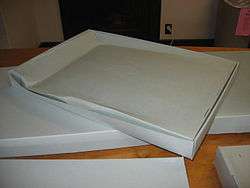Creep (deformation)
In materials science, creep (sometimes called cold flow) is the tendency of a solid material to move slowly or deform permanently under the influence of mechanical stresses. It can occur as a result of long-term exposure to high levels of stress that are still below the yield strength of the material. Creep is more severe in materials that are subjected to heat for long periods, and generally increases as they near their melting point.
The rate of deformation is a function of the material properties, exposure time, exposure temperature and the applied structural load. Depending on the magnitude of the applied stress and its duration, the deformation may become so large that a component can no longer perform its function — for example creep of a turbine blade will cause the blade to contact the casing, resulting in the failure of the blade. Creep is usually of concern to engineers and metallurgists when evaluating components that operate under high stresses or high temperatures. Creep is a deformation mechanism that may or may not constitute a failure mode. For example, moderate creep in concrete is sometimes welcomed because it relieves tensile stresses that might otherwise lead to cracking.
Unlike brittle fracture, creep deformation does not occur suddenly upon the application of stress. Instead, strain accumulates as a result of long-term stress. Therefore, creep is a "time-dependent" deformation.
Temperature dependence
The temperature range in which creep deformation may occur differs in various materials. For example, tungsten requires a temperature in the thousands of degrees before creep deformation can occur, while ice will creep at temperatures near 0 °C (32 °F).[1] As a general guideline, the effects of creep deformation generally become noticeable at approximately 35% of the melting point (as measured on a thermodynamic temperature scale such as Kelvin or Rankine) for metals, and at 45% of melting point for ceramics.[2] Virtually any material will creep upon approaching its melting temperature. Since the creep minimum temperature is related to the melting point, creep can be seen at relatively low temperatures for some materials. Plastics and low-melting-temperature metals, including many solders, can begin to creep at room temperature, as can be seen markedly in old lead hot-water pipes. Glacier flow is an example of creep processes in ice.
Stages of creep

In the initial stage, or primary creep, the strain rate is relatively high, but slows with increasing time. This is due to work hardening. The strain rate eventually reaches a minimum and becomes near constant. This is due to the balance between work hardening and annealing (thermal softening). This stage is known as secondary or steady-state creep. This stage is the most understood. The characterized "creep strain rate" typically refers to the rate in this secondary stage. Stress dependence of this rate depends on the creep mechanism. In tertiary creep, the strain rate exponentially increases with stress because of necking phenomena or internal voiding decreases the effective area of the specimen. Fracture always occurs at the tertiary stage.
Mechanisms of creep
The mechanism of creep depends on temperature and stress. Various mechanisms are:
- Bulk diffusion (Nabarro-Herring creep)
- Climb — here the strain is actually accomplished by climb
- Climb-assisted glide — here the climb is an enabling mechanism, allowing dislocations to get around obstacles
- Grain boundary diffusion (Coble creep)
- Thermally activated glide — e.g., via cross-slip
General creep equation
where is the creep strain, C is a constant dependent on the material and the particular creep mechanism, m and b are exponents dependent on the creep mechanism, Q is the activation energy of the creep mechanism, σ is the applied stress, d is the grain size of the material, k is Boltzmann's constant, and T is the absolute temperature.
Dislocation creep
At high stresses (relative to the shear modulus), creep is controlled by the movement of dislocations. For dislocation creep, Q = Q(self diffusion), m = 4–6, and b = 0. Therefore, dislocation creep has a strong dependence on the applied stress and no grain size dependence.
Some alloys exhibit a very large stress exponent (n > 10), and this has typically been explained by introducing a "threshold stress," σth, below which creep can't be measured. The modified power law equation then becomes:
where A, Q and n can all be explained by conventional mechanisms (so 3 ≤ n ≤ 10).
Nabarro-Herring creep

Nabarro-Herring creep is a form of diffusion creep. In Nabarro-Herring creep, atoms diffuse through the lattice causing grains to elongate along the stress axis; k is related to the diffusion coefficient of atoms through the lattice, Q = Q(self diffusion), m = 1, and b = 2. Therefore, Nabarro-Herring creep has a weak stress dependence and a moderate grain size dependence, with the creep rate decreasing as grain size is increased.
Nabarro-Herring creep is strongly temperature dependent. For lattice diffusion of atoms to occur in a material, neighboring lattice sites or interstitial sites in the crystal structure must be free. A given atom must also overcome the energy barrier to move from its current site (it lies in an energetically favorable potential well) to the nearby vacant site (another potential well). The general form of the diffusion equation is D = D0exp(E/KT) where D0 has a dependence on both the attempted jump frequency and the number of nearest neighbor sites and the probability of the sites being vacant. Thus there is a double dependence upon temperature. At higher temperatures the diffusivity increases due to the direct temperature dependence of the equation, the increase in vacancies through Schottky defect formation, and an increase in the average energy of atoms in the material. Nabarro-Herring creep dominates at very high temperatures relative to a material's melting temperature.
Coble creep
Coble creep is a second form of diffusion controlled creep. In Coble creep the atoms diffuse along grain boundaries to elongate the grains along the stress axis. This causes Coble creep to have a stronger grain size dependence than Nabarro-Herring creep. For Coble creep k is related to the diffusion coefficient of atoms along the grain boundary, Q = Q(grain boundary diffusion), m = 1, and b = 3. Because Q(grain boundary diffusion) < Q(self diffusion), Coble creep occurs at lower temperatures than Nabarro-Herring creep. Coble creep is still temperature dependent, as the temperature increases so does the grain boundary diffusion. However, since the number of nearest neighbors is effectively limited along the interface of the grains, and thermal generation of vacancies along the boundaries is less prevalent, the temperature dependence is not as strong as in Nabarro-Herring creep. It also exhibits the same linear dependence on stress as Nabarro-Herring creep.
Harper-Dorn creep
Harper-Dorn creep is a climb-controlled dislocation mechanism at low stresses that has been observed in aluminum, lead, and tin systems, in addition to nonmetal systems such as ceramics and ice. It is characterized by two principal phenomena: a linear relationship between the steady-state strain rate and applied stress at a constant temperature, and an independent relationship between the steady-state strain rate and grain size for a provided temperature and applied stress. The latter observation implies that Harper-Dorn creep is controlled by dislocation movement; namely, since creep can occur by vacancy diffusion (Nabarro-Herring creep, Coble creep), grain boundary sliding, and/or dislocation movement, and since the first two mechanisms are grain-size dependent, Harper-Dorn creep must therefore be dislocation-motion dependent.[3]
However, Harper-Dorn creep is typically overwhelmed by other creep mechanisms in most situations, and is therefore not observed in most systems. The phenomenological equation which describes Harper-Dorn creep is:
where: is dislocation density (constant for Harper-Dorn creep), is the diffusivity through the volume of the material, is the shear modulus, is the Burger's vector, is the applied stress, is Boltzmann's constant, and is temperature.
The volumetric activation energy indicates that the rate of Harper-Dorn creep is controlled by vacancy diffusion to and from dislocations, resulting in climb-controlled dislocation motion.[4][5] Unlike in other creep mechanisms, the dislocation density here is constant and independent of the applied stress.[3] Moreover, the dislocation density must be low for Harper-Dorn creep to dominate. The density has been proposed to increase as dislocations move via cross-slip from one slip-plane to another, thereby increasing the dislocation length per unit volume. Cross-slip can also result in jogs along the length of the dislocation, which, if large enough, can act as single-ended dislocation sources.[6]
Examples
Creep of polymers

Creep can occur in polymers and metals which are considered viscoelastic materials. When a polymeric material is subjected to an abrupt force, the response can be modeled using the Kelvin-Voigt model. In this model, the material is represented by a Hookean spring and a Newtonian dashpot in parallel. The creep strain is given by the following convolution integral:
where:
- σ = applied stress
- C0 = instantaneous creep compliance
- C = creep compliance coefficient
- = retardation time
- = distribution of retardation times
When subjected to a step constant stress, viscoelastic materials experience a time-dependent increase in strain. This phenomenon is known as viscoelastic creep.
At a time t0, a viscoelastic material is loaded with a constant stress that is maintained for a sufficiently long time period. The material responds to the stress with a strain that increases until the material ultimately fails. When the stress is maintained for a shorter time period, the material undergoes an initial strain until a time t1 at which the stress is relieved, at which time the strain immediately decreases (discontinuity) then continues decreasing gradually to a residual strain.
Viscoelastic creep data can be presented in one of two ways. Total strain can be plotted as a function of time for a given temperature or temperatures. Below a critical value of applied stress, a material may exhibit linear viscoelasticity. Above this critical stress, the creep rate grows disproportionately faster. The second way of graphically presenting viscoelastic creep in a material is by plotting the creep modulus (constant applied stress divided by total strain at a particular time) as a function of time.[7] Below its critical stress, the viscoelastic creep modulus is independent of stress applied. A family of curves describing strain versus time response to various applied stress may be represented by a single viscoelastic creep modulus versus time curve if the applied stresses are below the material's critical stress value.
Additionally, the molecular weight of the polymer of interest is known to affect its creep behavior. The effect of increasing molecular weight tends to promote secondary bonding between polymer chains and thus make the polymer more creep resistant. Similarly, aromatic polymers are even more creep resistant due to the added stiffness from the rings. Both molecular weight and aromatic rings add to polymers' thermal stability, increasing the creep resistance of a polymer.[8]
Both polymers and metals can creep. Polymers experience significant creep at temperatures above ca. –200 °C; however, there are three main differences between polymeric and metallic creep.[9]
Polymers show creep basically in two different ways. At typical work loads (5 up to 50%) ultra high molecular weight polyethylene (Spectra, Dyneema) will show time-linear creep, whereas polyester or aramids (Twaron, Kevlar) will show a time-logarithmic creep.
Creep of concrete
The creep of concrete, which originates from the calcium silicate hydrates (C-S-H) in the hardened Portland cement paste (which is the binder of mineral aggregates), is fundamentally different from the creep of metals as well as polymers. Unlike the creep of metals, it occurs at all stress levels and, within the service stress range, is linearly dependent on the stress if the pore water content is constant. Unlike the creep of polymers and metals, it exhibits multi-months aging, caused by chemical hardening due to hydration which stiffens the microstructure, and multi-year aging, caused by long-term relaxation of self-equilibrated micro-stresses in the nano-porous microstructure of the C-S-H. If concrete is fully dried it does not creep, though it is difficult to dry concrete fully without severe cracking.
Applications

Though mostly due to the reduced yield strength at higher temperatures, the collapse of the World Trade Center was due in part to creep from increased temperature operation.[10]
The creep rate of hot pressure-loaded components in a nuclear reactor at power can be a significant design constraint, since the creep rate is enhanced by the flux of energetic particles.
Creep in epoxy anchor adhesive was blamed for the Big Dig tunnel ceiling collapse in Boston, Massachusetts that occurred in July 2006.[11]
The design of tungsten light bulb filaments attempts to reduce creep deformation. Sagging of the filament coil between its supports increases with time due to the weight of the filament itself. If too much deformation occurs, the adjacent turns of the coil touch one another, causing an electrical short and local overheating, which quickly leads to failure of the filament. The coil geometry and supports are therefore designed to limit the stresses caused by the weight of the filament, and a special tungsten alloy with small amounts of oxygen trapped in the crystallite grain boundaries is used to slow the rate of Coble creep.
Creep can cause gradual cut-through of wire insulation, especially when stress is concentrated by pressing insulated wire against a sharp edge or corner. Special creep-resistant insulations such as Kynar (polyvinylidene fluoride) are used in wirewrap applications to resist cut-through due to the sharp corners of wire wrap terminals. Teflon insulation is resistant to elevated temperatures and has other desirable properties, but is notoriously vulnerable to cold-flow cut-through failures caused by creep.
In steam turbine power plants, pipes carry steam at high temperatures (566 °C (1,051 °F)) and pressures (above 24.1 MPa or 3500 psi). In jet engines, temperatures can reach up to 1,400 °C (2,550 °F) and initiate creep deformation in even advanced-design coated turbine blades. Hence, it is crucial for correct functionality to understand the creep deformation behavior of materials.
Creep deformation is important not only in systems where high temperatures are endured such as nuclear power plants, jet engines and heat exchangers, but also in the design of many everyday objects. For example, metal paper clips are stronger than plastic ones because plastics creep at room temperatures. Aging glass windows are often erroneously used as an example of this phenomenon: measurable creep would only occur at temperatures above the glass transition temperature around 500 °C (932 °F). While glass does exhibit creep under the right conditions, apparent sagging in old windows may instead be a consequence of obsolete manufacturing processes, such as that used to create crown glass, which resulted in inconsistent thickness.[12][13]
Fractal geometry, using a deterministic Cantor structure, is used to model the surface topography, where recent advancements in thermoviscoelastic creep contact of rough surfaces are introduced. Various viscoelastic idealizations are used to model the surface materials, for example, Maxwell, Kelvin-Voigt, Standard Linear Solid and Jeffrey media.[14]
Nimonic 75 has been certified by the European Union as a standard creep reference material.[15]
Preventing creep
There are four general ways to prevent creep in metal. One way is to use higher melting temperature metals. The second way is to use materials with greater grain size. The third way is to use alloying. Finally, the last way is to use intelligent design to reduce the possible factors of creep.
See also
References
- ↑ "Rheology of Ice". Archived from the original on 2007-06-17. Retrieved 2008-10-16.
- ↑ Ashy, Michael (2014). Materials. Oxford: Elsevier. p. 336. ISBN 978-0-08-097773-7.
- 1 2 Mohamed, F. A.; Murty, K. L.; Morris, J. W. (April 1973). "Harper-dorn creep in al, pb, and sn". Metallurgical Transactions. 4 (4): 935–940. doi:10.1007/BF02645593.
- ↑ Kassner, M.E; Pérez-Prado, M.-T (January 2000). "Five-power-law creep in single phase metals and alloys". Progress in Materials Science. 45 (1): 1–102. doi:10.1016/S0079-6425(99)00006-7.
- ↑ Paufler, P. (October 1986). "J.-P. Poirier. Creep of crystals. High-temperature deformation processes in metals, ceramics and minerals. Cambridge University Press. Cambridge – London – New York – New Rochelle – Melbourne – Sydney 1985. 145 figs., XII + 260 p., price £ 10.95 (paperback). ISBN 0-521-27851-1". Crystal Research and Technology. 21 (10): 1338–1338. doi:10.1002/crat.2170211021.
- ↑ Mohamed, Farghalli A.; Ginter, Timothy J. (October 1982). "On the nature and origin of Harper-Dorn creep". Acta Metallurgica. 30 (10): 1869–1881. doi:10.1016/0001-6160(82)90027-X.
- ↑ Rosato, D. V. et al. (2001) Plastics Design Handbook. Kluwer Academic Publishers. pp. 63–64. ISBN 0792379802.
- ↑ M. A. Meyers; K. K. Chawla (1999). Mechanical Behavior of Materials. Cambridge University Press. p. 573. ISBN 978-0-521-86675-0.
- ↑ McCrum, N.G, Buckley, C.P; Bucknall, C.B (2003). Principles of Polymer Engineering. Oxford Science Publications. ISBN 0-19-856526-7.
- ↑ Zdeněk Bažant and Yong Zhu, "Why Did the World Trade Center Collapse?—Simple Analysis", Journal of Engineering Mechanics, January 2002
- ↑ "Ceiling Collapse in the Interstate 90 Connector Tunnel". National Transportation Safety Board. Washington, D.C.: NTSB. July 10, 2007. Retrieved 2 December 2016.
- ↑ Lakes, Roderic S. (1999). Viscoelastic Solids. p. 476. ISBN 0-8493-9658-1.
- ↑ "Is glass liquid or solid?". University of California, Riverside. Retrieved 2008-10-15.
- ↑ Osama Abuzeid, Anas Al-Rabadi, Hashem Alkhaldi . Recent advancements in fractal geometric-based nonlinear time series solutions to the micro-quasistatic thermoviscoelastic creep for rough surfaces in contact, Mathematical Problems in Engineering, Volume 2011, Article ID 691270
- ↑ https://ec.europa.eu/jrc/sites/default/files/rm/BCR-425_report.pdf
Further reading
- Ashby, Michael F.; Jones, David R. H. (1980). Engineering Materials 1: An Introduction to their Properties and Applications. Pergamon Press. ISBN 0-08-026138-8.
- Frost, Harold J.; Ashby, Michael F. (1982). Deformation-Mechanism Maps: The Plasticity and Creep of Metals and Ceramics. Pergamon Press. ISBN 0-08-029337-9.
- Turner, S (2001). Creep of Polymeric Materials. Oxford: Elsevier Science Ltd. pp. 1813–1817. ISBN 0-08-043152-6.
External links
- Creep Analysis Research Group – Politecnico di Torino
- Deformation-Mechanism Maps, The Plasticity and Creep of Metals and Ceramics
- The National Institute of Standards and Technology – WTC Briefing
- "Introduction to Creep". Archived from the original on 2008-06-17. Retrieved 2008-10-16.